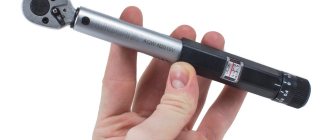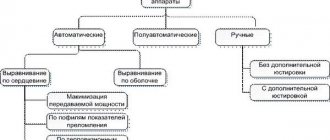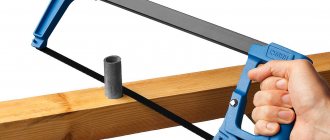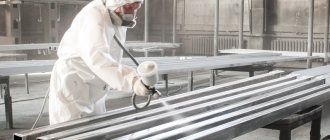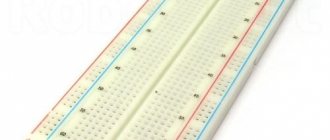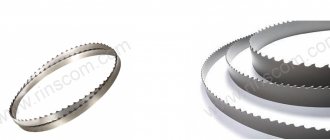One of the main tools for working with various materials for a home craftsman is a hacksaw. It has several varieties, used depending on the type of surface being treated. It is important to know how to use each of them correctly.
What is a hacksaw?
In carpentry, a hacksaw is a special type of hand saw designed for cutting wood, metal, aerated concrete, plastic and other materials. Scientists find mention of the first such instruments in ancient times in the civilizations of Egypt, Greece and Rome. Over the course of its centuries-old history, the hacksaw has undergone significant changes, but has not lost its relevance and is always kept in a set of basic tools for a home craftsman.
Hacksaw device
Like any other carpentry tool, a hacksaw has a certain structure that affects its performance characteristics. It consists of:
- Working, hacksaw or saw blade. It is made of metal of various alloys, which, together with the size, affect the purpose of the tool. Another important parameter of the working blade is the number, shape and size of the teeth. Thanks to them, the surface is divided into parts using the reciprocating movements of the master.
- The working blade is attached and securely fixed to the handle or a special frame. It performs the functions of fixation, protection and ease of use. When selecting a saw, you must take into account its ergonomics.
Features of the instrument
The design of the saw is formed by the same basic components - a cutting metal blade and a handle. The fundamental feature of the device can be called the presence of that same pad. This is an overhead part on the top of the canvas that acts as a stiffener. What is this add-on for? A traditional hacksaw produces slight vibrations in the blade during the sawing process, which slow down the work and can affect the quality of the result. In order to minimize “hanging”, manufacturers increase the rigidity of the canvas by increasing its thickness. The negative effect of such a change in parameters will be the expansion of the cutting area, which is unacceptable in the delicate processing of small structures and parts. In turn, the back saw, precisely due to the additional device with increased rigidity, eliminates the effect of vibration, while maintaining a moderate thickness of the blade. This tool is also distinguished by a small, hardened tooth, which allows it to perform precise and neat cuts.
What is a hacksaw for?
Having understood the definition of what a hacksaw is, it is worthwhile to dwell in more detail on the areas of its application:
- This tool is widely used in gardening for pruning trees and shrubs, cutting down knots and rough parts of wood.
- A hacksaw is used to saw wooden parts during construction and household repairs.
- It is used to cut out figures from plywood, make curved cuts or make through holes.
- There are special varieties for sawing metal sheets and pipes, aerated concrete blocks.
- Some modifications include cutting grooves, tenons and recessed holes.
What types of hand saws are used for what purposes?
- The classic hacksaw is the most common of all. It has a long and wide canvas. If the blade is too long, the hacksaw may tilt to the side when cutting. Great care must be taken to avoid deviation of the cutting line from the initial marking. This hacksaw is suitable for working with timber, boards, chipboard and so on.
- Hacksaw with back. This saw model has a rigid rib attachment, which minimizes the vibration frequency of the blade. This hacksaw also has smaller teeth and a higher TPI coefficient. They are designed for cutting plywood, chipboard with a coating layer and sawing profile strips.
- Finish saws have an adjustable handle. They are needed for cutting grooves, grooves and straight and profile planks.
- A circular hacksaw, or a hacksaw with a narrow blade. It is also used for cutting grooves, as well as for cutting out parts with rounded areas and large holes.
- A bow saw is well suited for cutting knots and rough parts of material, as well as for cutting out parts from plywood and wood. This hacksaw is distinguished by a thin blade fixed on both sides in a frame. It is worth noting that you need to work with it extremely carefully due to its increased fragility.
- The award has two handles. The appearance of such a saw is in many ways similar to a plane. It is used for cutting tenons and grooves, deepening holes and slots in materials of any hardness.
- Garden saw with curved blade. Most often, for greater convenience, they are made folding. This saw is well suited for garden work. The saw blade is made of chrome steel. Widely spaced teeth with an inclination in the direction of the handle will allow you to conveniently cut down twigs and branches, placing emphasis on yourself while cutting.
- A two-handed saw has the highest productivity. It has two wooden handles. For greater efficiency, cutting with such a saw requires two people. A two-handed saw is often used for sawing large logs and trees.
- A hand or pocket chain saw is a small piece of chain with two handles on the ends. This saw is convenient for both one and two people to work with. The log or branch is wrapped around a chain and cut is made using the handles. A manual chainsaw, like a folding one, is well suited for gardening.
Types of hand saws
This classic hacksaw can be easily sharpened
This hacksaw has hardened teeth and increased wear resistance
A hacksaw with a back or butt minimizes vibration of the blade during operation
A hacksaw with a narrow blade is well suited for cutting holes and grooves
This saw has an adjustable handle, which allows you to work at the desired angle.
A bow saw is well suited for cutting parts from plywood.
This type of hacksaw is similar to a plane and is used for cutting tenons and slots.
Two-handed saw suitable for cutting large logs
Garden saws with curved blades are well suited for cutting down knots and small tree branches.
The hand chain saw is compact and well suited for sawing logs while camping and branches in the garden.
Thus, having carefully studied all the nuances regarding hand saws, everyone will be able to choose the most suitable option for themselves. Choosing the right tool will provide you with high-quality and enjoyable work.
How is a hacksaw different from a saw?
One of the main and frequently used types of saws is the hacksaw. It differs from other instruments in this group in that:
- This is an exclusively hand tool. The hacksaw saw is driven only by the reciprocating movements of the master’s hands. Whereas other saws can be electric or gasoline.
- When using a hacksaw, only return movements are used, while other saws can be circular.
- In the usual configuration, such a tool has one handle for the master to work alone.
- It has a mostly straight cutting blade, whereas analogues may have a chain, tape or disk.
- A hacksaw has only teeth on the working edge, while other varieties may contain abrasive.
Choose and purchase a quality hacksaw for the job?
We are pleased to offer a wide selection of construction tools at excellent prices. We always have popular product items in stock, so you can choose the necessary hacksaw and receive your goods in the shortest possible time.
Our experienced specialists are always ready to advise on the technical features of different types of hacksaws and will help you make the right choice based on the further scope of the tool. Contact the phone numbers listed on the website or fill out an application on the website to purchase a reliable hacksaw from a leading manufacturer at an excellent price.
Types of hacksaws
The whole variety of hacksaws can be divided into tools for:
- Works with wooden surfaces
. This includes both a universal saw and a garden hacksaw, and some other special varieties. - Treatment of metal surfaces
. This group also has its own modifications for masters of different classes. - Work with aerated concrete
.
The structure of the instrument is:
- Standard with one handle.
- There are modifications with a solid frame.
- A specialized tool is a folding hacksaw, which is an attribute of a traveler's tool kit.
Hacksaw for metal
Often, professional craftsmen use a special carpentry hacksaw for metal, which has the following varieties:
- Classic model with a special frame
. It is often equipped with a rubberized handle for ease of use. Using this model, you can make cuts in sheet metal at angles of 90º and 55º. - Hand hacksaw
. It consists of a special handle to which the equipment is attached only on one side. The special shape of the bracket allows for working in difficult conditions and creating internal cuts.
Wood hacksaw
The largest number of varieties of hacksaws are designed for working with wood. Among them, the popular ones are:
- A classic saw, also called a standard or regular saw. It is a standard tool with a wide cutting blade for straight longitudinal or cross cutting. The number and size of teeth may vary depending on the modification.
- Circular or narrow tool
. It differs from the classic model in that the hacksaw blade is much narrower. This saw is more maneuverable. It is more convenient to cut sheet material along a given contour. - A bow saw has a thin, curved shackle
. This tool is convenient for cutting tree branches and doing other work in the garden. Some varieties have a special connector for attaching a rod for working with high branches. - Passing saw
. It is also called spike or abutment. It is used by carpenters or joiners to remove protruding mortises or tenons, that is, to obtain an even cut.
Hacksaw for aerated concrete
A special type of tool is a hacksaw for foam blocks, specially designed for separating or removing excess parts of aerated concrete. This fragile material requires special tools with hard-melting tips on the teeth. Thanks to this technology it is possible to:
- Extend tool life. Special soldering prevents abrasion and wear of the teeth, making it possible to cut large quantities of aerated concrete.
- A hacksaw for drywall or wood is much sharper, but it cannot be used for foam blocks, since the materials have different densities and rigidities. Special equipment simplifies and speeds up the process of dividing blocks into parts.
- Eliminate the need to buy expensive electric or gas-powered devices for working with gas silicate.
How to choose the right hacksaw for concrete?
Hand hacksaws are actively used in modern construction, as they allow you to easily and quickly make additional elements from aerated concrete, gas silicate, foam concrete blocks, expanded clay, various types of bricks, and plasterboard.
This tool has many advantages in use:
- Versatility of use. Hacksaws can be used to cut almost any building concrete blocks, with the only exception being reinforced concrete structures.
- High quality of cutting, that is, the surface will not need to be processed a second time in another mechanical way, but the finished element will immediately be used when laying walls and other structures.
- Possibility of use in residential premises, since hacksaws do not emit any extraneous noise during operation.
- Good speed of work without extra effort.
- The ability to carry out repair work on construction sites that are deprived of electricity. And this is a very common problem for many suburban properties.
- The ability to work under unfavorable conditions, since such a tool is not at all afraid of high humidity or exposure to aggressive environments.
- You do not need any special skills to operate the tool.
- Minimum safety requirements.
Therefore, in the construction industry it is impossible to do without a hacksaw.
When choosing a cutting tool for working with concrete blocks, the following performance characteristics must be taken into account:
- Working blade length. The most commonly used standard blade length is from 35 to 50 cm.
- Thickness of the cutting part. If you have to work with a harder material, then it is better to choose a blade with a thicker thickness.
- The presence of soldering on the teeth. Such models are characterized by higher strength and reliability, and are durable in operation.
It is also worth paying attention to the material used to make the blade; there are 2 main types of hacksaws for concrete:
- made of high-strength steel, which are excellent for cutting hard concrete products;
- made of bimetallic alloys, this is the best option for cutting light porous cellular concrete.
It is also recommended to choose a tool with a large number of teeth, as it will provide a better and more accurate cut.
Types of hacksaw teeth
All the models described above differ not only in the shape of the blade for a hacksaw for metal or wood, but also in the size and sharpening angle of the teeth. According to shape and sharpening, all teeth are divided into:
- Equipment for longitudinal sawing along the grain. It is equipped with large teeth sharpened at right angles.
- For cross-cutting layers of workpieces. The edges of the teeth are sharpened at an angle and slightly tilted back.
- The so-called Japanese teeth for cross cutting. They differ from the standard analogue by longer teeth and a double slope of the cutting edge.
- Universal teeth of symmetrical size, sharpened along the edges. Suitable for longitudinal and cross cutting.
The size of the teeth is:
- Small, about 2-2.5 mm long.
- Medium, the size of which is around 3-3.5 mm.
- Teeth with a length of 4-6 mm are considered large.
HANDSAWS (HACKSAWS) FOR WOOD. LET'S LOOK 'INTO THE JAW' OF THE TAME 'PREDATOR'.
Wood is a natural material based on high-strength fibers. Under compressive, tensile and bending loads, its specific strength is not inferior to many metals. It is not for nothing that until the mid-thirties wood remained one of the main structural materials in
aviation, inferior to duralumin only in manufacturability, but not in specific strength. It is not so easy to destroy the structure of wood.
HAND SAWS (HACKSAWS) are one of the main TOOLS for woodworking. And not only - they are also used for processing various artificial materials, such as chipboard, laminate, PVC. In order for a HAND SAW (HACKSAW) to work, its teeth must be set apart. DEVELOPMENT is a mechanical deviation of the teeth to the sides so that the width of the cut exceeds the width of the blade, otherwise it will “wedge.” However, a cut that is too wide is also not necessary, because it will take additional effort to create it. For example, according to the specifications of the well-known manufacturer of HANDSAWS (HACKSAWS) - the company STANLEY - with a blade thickness of 0.75 mm, the cutting width, determined by the spread of the SAW TEETH, should be 1.25 mm. As for the size of SAW TEETH, in Russia the practice of indicating it has not taken root. In the rest of the world, it is customary to indicate the pitch of the SAW TOOTH in the number of “teeth per inch” (TPI – TOOTH PER INCH) or the number of “points per inch” (PPI – POINTS PER INCH), which is recalculated from TPI using the formula PPI = TPI + 1 They are often indicated together through a fraction, for example, “7/8”. In practice, the SAW TOOTH size is used from approximately 2.5/3.5 for HANDSAWS (HACKSAWS) for rough work with raw wood and up to 14/15 for HANDSAWS (HACKSAWS) for fine work. There were practically no specialized HANDSAWS (HACKSAWS) created for working with artificial materials, but the need to process them significantly influenced the evolution of HANDSAWS (HACKSAWS) for wood. It went in several directions: improving the shapes and layout of SAW TEETH contributed to increased efficiency, and the use of modern materials and processing technologies contributed to the durability of products. The DAGGER TOOTH has the shape of an isosceles triangle and cutting edges on both sides, sharpened at an acute angle. It works when moving in any direction and is therefore the main type of SAW TOOTH in BOW SAW blades. However, due to the acute sharpening angle, it is not suitable for sawing along the fibers, since it does not destroy them, but only splits them. In this case, the SAW TEETH characteristically become jammed in the split fibers and sawing becomes significantly more difficult. The chisel-shaped tooth has the shape of an asymmetrical triangle, inclined forward in the sawing direction. Its top is sharpened across the blade, and it acts like a CHISEL. Such a SAW TOOTH cuts perfectly along the fibers, but across it clings to them, requires additional effort, in other words, it practically does not saw. AN OBLIQUE UNIVERSAL TOOTH is a cross between a DAGGER and a CHISEL TOOTH. This is an asymmetrical triangle, the front edge of which is sharpened at a relatively large angle to the blade - about 60 degrees - and therefore can also work when sawing along the grain. The sharpening angle, which is blunter than that of a DAGGER SAW TEETH, does not particularly affect the efficiency when sawing across the fibers, since, cut by the sharp tips of the SAW TEETH, they are destroyed quite well by such an edge. Using this type of SAW TOOTH, you can easily cut out, for example, a circle. TOOTH WITH A GROUNDED TOP. Sometimes for some reason it is called triangular. It is formed from a DAGGER or OBLIQUE UNIVERSAL SAW TOOTH by partially grinding off the top. Due to this, three additional cutting edges are formed, which significantly improve the properties of the SAW TOOTH and allow you to make cuts both along and across the fibers. This SAW TOOTH shape is very similar to STANLEY's JET-CUT shape. JAPANESE TOOTH. Unlike other types of SAW TEETH, which are formed on a flat blade, this SAW TEETH requires a blade that is wedge-shaped in cross-section. It is cut in a wider part of the canvas and due to this does not require wiring. This SAW TOOTH is inclined to one side and cuts only in the direction of the inclination, and the sharp cutting edge angle and the large relative height of the SAW TOOTH make it so aggressive that it can only work with very small feed forces. A HANDSAW (HACKSAW) with such a SAW TOOTH can be sawed exclusively when moving “towards you,” which is traditional for Japan. Hence the name SAW TOOTH. Until recently, the schemes for alternating SAW TEETH did not shine with variety: most used exactly the same SAW TEETH, sharpened at opposite angles with the opposite set. So the considered forms of SAW TEETH have a historical value rather than a practical one. Using, for example, a HAND SAW (HACKSAW) with a DAGGER-shaped SAW TOOTH for longitudinal sawing leads to a very obvious effect of the TOOL getting stuck in the wood, while a CHISEL-shaped tool, when trying to cut across the grain, gives the feeling of the blade jumping in your hands. What new have the leading manufacturers of HANDSAWS (HACKSAWS) come up with in this matter? JET-CUT - STANLEY sharpening uses straight DAGGER SAW TEETH with a ground top, grouped in groups of eight. In each group, six SAW TEETH are set apart in a row, but the last two are not. They provide additional cutting of fibers closer to the center of the cut and active removal of sawdust from its area. Sawing across and along the grain. XT – sharpening from SANDVIK. The basic shape of a SAW TOOTH is an oblique UNIVERSAL, inclined forward at a small angle, that is, almost DAGGER. Two such unset SAW TEETH with opposite sharpening angles are followed by the same SAW TOOTH, but with the top ground off and set apart. Today, HANDSAWS (HACKSAWS) with such sharpening are, apparently, the best in almost all indicators - efficiency, required force, cleanliness of the cut, durability. This is due to the fact that such SAW TEETH “do not do extra work” - the first ones cut the fibers, and the last one “completes the work”. Alternating groups of SAW TEETH with small and large cavities is used by manufacturers of HANDSAWS (HACKSAWS) and SAW BLADES for raw wood. An example of such a solution is the so-called WOLF TOOTH of a BOW SAW blade. The problem is that the fibers of raw wood are difficult to break down, and when sawing it, relatively large chips are formed, which do not fit into the small interdental spaces and clog the cut. Enlargement of the interdental cavity (GALTELI) allows you to cope with this. There are several options for such a grouping of SAW TEETH, in particular, the so-called KREMLIN TOOTH, which is obtained manually on domestic HANDSAWS (HACKSAWS) by removing every third SAW TEETH and sawing out a cavity in its place. The optimal size of the SAW TOOTH in terms of efficiency is determined by the amount of pressure on the blade and the amplitude of movement of the HAND SAW (HACKSAW). For modern SAW TEETH (XT, JET-CUT, UNIVERSAL OBLIQUE), the force and range that an average man can develop over a long period of time corresponds to a “7/8” pitch. This is exactly the size of the SAW TOOTH, most often found on modern HANDSAWS (HACKSAWS) from leading manufacturers. The durability of the SAW TEETH is also determined by its shape and the quality of sharpening. It is equally important to maintain the equality of height and sharpness of all SAW TEETH. Otherwise, the sharper and taller ones have an increased load, and they quickly become dull. For this reason, for example, factory machine sharpening is several times higher in durability than subsequent manual sharpenings of the same blade. The most resistant sharpening is the XT type - sharpening from SANDVIK, since it is optimized for the distribution of load between cutting edges for various purposes. The configuration of the SAW TEETH and the various techniques for alternating them appear to be important. But first of all, the quality of a HAND SAW (HACKSAW) is determined by the quality of the steel used for its manufacture. It is subject to quite stringent requirements: high strength and elasticity, ability to accept sharpening, durability of the cutting edge. Good metal does not crumble, does not bend under the action of a sharpening TOOL, the mark is not lost, and the blade takes its original shape after inevitable deformations during use. The technology for forming SAW TEETH is the second most important factor affecting the quality of a HANDSAW (HACKSAW). The best way is to cut the SAW TEETH with a grinding wheel on a CNC machine. In its more advanced version, a wide – the width of the SAW TOOTH profile – profiled circle cuts SAW TEETH on a package of several dozen blades in two passes. Additional hardening and tempering of the SAW TEETH is carried out using the method of induction heating with air cooling. Then the setting is formed by bending the SAW TEETH on a special production line. Cutting out SAW TEETH requires significantly lower equipment costs and for this reason is used in numerous domestic enterprises that produce HANDSAWS (HASSAWS), (alas, as a rule, with little success). The main disadvantage of this technology is that it does not solve the sharpening issue at all. As a result, domestic HANDSAWS (HACKSAWS) are not sharpened by the manufacturer at all and are suitable for use only after sharpening and setting, which require special TOOLS and high qualifications. The use of steel with high elasticity for the HANDSAW (HACKSAW) blade and the use of a SAW TOOTH no larger than “7/8” make it unnecessary to set the SAW TEETH throughout the entire service life of the HANDSAW (HACKSAW). When sharpening on CNC machines, the required sharpening angles and, most importantly, the height of the SAW TEETH are maintained with very high precision, so the efficiency of the HAND SAW (HACKSAW) is maximum. Subsequent manual sharpening cannot provide such accuracy, and after it the efficiency reaches, at best, 70 - 80% of the initial one, and when sharpening is performed by a person who does not have the proper experience, it is much lower. The most efficient types of SAW TEETH, for example, BAHCO XT and STANLEY JET-CUT, could hardly be sharpened by hand - the planes on which the tops of the SAW TEETH are ground are too shallow. In most European countries, the cost of labor time required to manually sharpen a HAND SAW (HACKSAW) far exceeds the retail cost of a new TOOL. In Russia now the situation is largely similar - often a “used” HAND SAW (HACKSAW) is simply thrown away. But just recently this was impossible to imagine!!! Additional hardening of the SAW TOOTH to high hardness increases its durability by 5 - 6 times compared to factory sharpening of the same quality and at the same time makes it impossible to sharpen a dull HAND SAW (HACKSAW) with a simple file. A hardened SAW TOOTH can only be slightly corrected using a diamond file. But you cannot use any kind of abrasive wheels, including diamond ones - inevitable heating will lead to uneven tempering of the SAW TOOTH and immediate destruction of the cutting edge when working with such a “restored” TOOL. Now let’s look directly at the main types of HANDSAWS (HACKSAWS) themselves...
Hamlet Vartushtyanyan
You can get answers to your questions by writing a letter to
Reproduction of materials is prohibited.
Website: https://eletos.ru/
| Reader rating: (4 votes) |
How to choose a hacksaw?
Before choosing in a store which hacksaw is best for wood or other materials, you should find out the basic criteria for purchasing a quality tool that will last a long time and function properly:
- Specialization of the model you like. It is worth carefully selecting what material you will work with. Tools for aerated concrete and gardening are significantly different.
- The grade of steel from which the cutting blade is made. High-speed and carbon alloys with a blade strength of 45 HRC and a cutting edge of at least 60 HRC perform best.
- Sharpening the teeth affects the quality of the cut in a certain direction or when working in hard-to-reach places. The universal sharpening is somewhat inferior in cutting quality to more specialized models.
- The length of the blade varies not only among different types of models, but also differs among tools of the same category.
- Comfortable handle. This parameter is especially important if the master will carry out a large amount of work with the tool. The more comfortable the hacksaw fits in the palm of your hand, the less your hand will get tired.
Cordless hacksaw
A special type of tool that has appeared relatively recently is the cordless reciprocating saw, which is also called an electric hacksaw. This device is useful when performing a large number of construction or gardening works. Its compact size allows you to use the electric hacksaw in confined spaces that would be difficult to handle with a conventional saw. Such a hacksaw should be selected based on its following characteristics:
- Battery capacity, which directly affects the operating time without recharging. Professional models can last about 5 hours before changing the battery.
- Voltage that affects the power and number of movements made by the saw per unit time.
- Possibility of connecting additional batteries to increase performance.
Main settings
The effectiveness of using a hacksaw for wood largely depends on its technical characteristics. The main ones are:
- the material from which the saw blade is made;
- length of the canvas and its shape;
- tooth size and shape;
- type of handle.
When choosing a tool, you need to pay attention to each element of the characteristics. Only in this case you won’t have to regret the purchase.
Canvas material
The blade of modern hacksaws for wood is made from high-quality tool (alloy) steel with a high content of carbon and silicon (65G, 8HF, U7...U10). The hardness must be at least HRC 45. There are also models that use a combined, more wear-resistant blade with a cutting part (teeth) that has increased hardness (HRC55...60).
Length and shape of the canvas
On the domestic market you can find hacksaws for wood with a length of 250 to 650 mm in increments of 25 mm. This parameter is specified by GOST 2615-84 and depends on the distance between the teeth.
Note! It is necessary to choose a saw, guided by the rule: “The length of the blade should be 2 times the thickness (diameter) of the workpiece.”
Otherwise, working with a hacksaw will be uncomfortable, since the short blade will jam inside the solid wood.
As a rule, hacksaws with a narrow blade are no more than 350 mm long and are equipped with a large number of small teeth. Tools for universal use are equipped with blades about 500 mm long with medium-sized teeth. Hacksaws with a wide blade are made with large teeth located at a large distance from each other (large pitch); their length can reach 650 mm.
Traditionally, a wood saw has the shape of a triangle narrowed on one side. This tool can work with any type of wood. In addition, there are hacksaws adapted for working, for example, with tree branches or other objects located at some distance from the sawyer. They have a rounded shape and are lightweight.
Tooth size and shape
The size of the teeth (pitch) of the hacksaw blade directly affects the performance and accuracy of the tool. The larger the teeth, the higher the speed, but the accuracy and quality of the cut deteriorates. Using a saw with fine teeth, on the contrary, guarantees a clean and even cut, but at the same time the speed decreases.
The cutting accuracy is determined by the number of teeth per 1 inch of blade length (TPI coefficient), that is, their density. Its value is marked on the side surface of the canvas (for example, 7x1″ or 7TPI). The higher the TPI, the smaller the pitch. So, 2TPI=12 mm, and 12TPI=2 mm.
When choosing a hacksaw for wood, you must take into account that the minimum thickness of the workpiece must be greater than a pitch of three teeth.
The appearance of sharpened teeth is essential when working with a hacksaw on wood. In this case, teeth that are sharpened on both sides and have the form of an acute-angled or isosceles triangle are considered standard.
Important! The latest generation of saws are equipped with hardened teeth of non-standard shape. They have the shape of a trapezoid and are distinguished by the presence of three sharpened edges and increased wear resistance. Blades with such teeth cannot be resharpened.
Handle type
The type of handle and the material from which it is made largely determine the ease of working with a hacksaw on wood. It is best to work with a saw equipped with a solid plastic handle with rubberized finger inserts. The handle, made of two parts, is less comfortable, as it does not have sufficient rigidity.
There are also hacksaws with reversible handles. They are usually equipped with universal and bow saws, in which blades can be changed during operation.
Hacksaw rating
Before purchasing a carpentry tool, you should pay attention to reviews from professionals and home craftsmen who have already assessed the quality of work with a particular hacksaw. The ranking of the most popular saws with excellent reviews includes:
- Gross Piranha 24101
is one of the best classic professional woodworking models with a comfortable handle from a German company with production in China. Cost – $20. - Vira 800240
is a high-quality domestic saw with three-sided teeth sharpening and additional hardening. High quality at a modest cost of about $7. - Stanley 1-15-122
– frame metal saw with a comfortable handle. Price – $8. - Stayer Max Cut
is a convenient folding type of woodworking tool that many hunters and tourists prefer to take with them. Price – $7. - Irwin 10505549
is a specialized tool for professional masons for working with aerated concrete blocks. Price – $24.
Unusual hacksaw options
Of course, in general terms, a hacksaw is a metalworking tool that is used for cutting various materials. But there are also specialized hiking hacksaws, which are more compact in size and allow you to quickly prepare firewood for a fire and perform any necessary work on arranging a parking lot.
Most of these models fold easily and take up minimal space, so they are very convenient to carry with you and carry out all your planned tasks without any problems.
There are also miniature metal files that can also be used on hikes. But they should be handled very carefully, since the working cloth is very flexible and fragile.
How to use a hacksaw?
The principles of working with basic plumbing tools, which include a hand saw, are simple, but failure to follow them can lead to a broken saw or a poor-quality cut. Main rules for handling the tool:
- The master takes a comfortable standing position with firm emphasis on his legs. Your elbows should bend at an angle of 90º.
- Reliable fixation of the sawn surface. If possible, it is better to secure the material in a vice.
- The hacksaw blade is firmly positioned strictly perpendicular to the surface. It is important to eliminate all vibrations of the instrument to prevent damage.
- Tools for metal are held with two hands, while tools for wood or aerated concrete are held with one.
Selection rules
If you will be using the saw for gardening work, a regular utility saw will do. If you are working with material that requires high-quality processing, then a saw with small teeth is suitable. For complex plumbing work, you will need a bow saw. The price of a good tool cannot be too low. If you want your hacksaw to serve you faithfully for a long time, then it is better to buy a more expensive tool and preferably from a well-known company. If possible, look through the reviews and look at the ratings of different types of saws, then choosing a good tool will not be difficult for you.
How to sharpen a hacksaw?
After carrying out a certain amount of work with a hacksaw, the saw teeth simply become dull. The first signs of the need for sharpening include:
- Heavy and uneven cutting.
- Uneven cut.
- The blade often gets stuck.
- It is difficult to maintain a given trajectory.
When the above “symptoms” appear, every master should understand how to sharpen a hacksaw while maintaining the working profile of the teeth:
- Securely fix the tool in a vice or clamp.
- Set the teeth. This procedure involves alternately bending each tooth in different directions by the same amount, approximately 1.5-2 mm, with a special tool.
- A triangular file with a fine notch is selected.
- The sharpening angle of the teeth is determined by eye, which is approximately 15-30º.
- Carry out the same number of file movements in the selected direction on one side. Repeat the process for the other side.
- The teeth are aligned in height.

